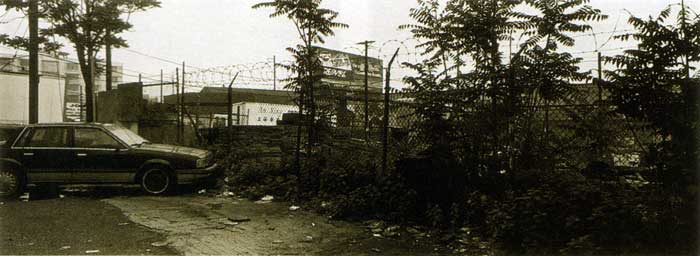For ‘Art on Paper’ Magazine

Michael Ashkin might agree with the New Jersey Tourist Board’s claim that the state is, “America the Beautiful, only smaller,” but his idea of beauty is found in the desolate landscape around chemical plants, truck yards and industrial compounds. Last year, he tramped through the undergrowth and slipped under fences to create a monumental photographic series based on the Meadowlands. Developed for efficient production rather than human enjoyment, these active work environments are so perfectly ugly that they challenge the notion of a ‘beautiful’ outdoor environment. Exploring the gritty side of the industrial aesthetic, Ashkin also traveled to the old mining town of Butte, Montana and locations in and around Palm Springs, California, producing eight photographic series for his third solo show at Andrea Rosen Gallery.
‘Meadowlands,’ is a group of 133 black and white photographs that was commissioned by Documenta XI. Presented in a compact grid, the photos formed one large composite that simulated the experience of seeing the Meadowlands as a series of glances from the Turnpike. Most photographs documented traces of a still active human presence: a memorial on a chain-link fence, a graffiti covered wall and a careful arrangement of truck storage containers along a canal. By contrast, the Butte series was a vision of advanced industrial decline. Shot on a hill near an abandoned pit mine, Ashkin’s subjects include a rusting basketball backboard, cracked building foundations and a lonesome bench next to an empty, six lane highway. Occasional disused mines appear in this series, but the focus is on the dilapidated housing and barren landscape of a dying neighborhood. Several shots were taken in or near the artist’s car, suggesting that he, too, would soon make his getaway.
In “Notes Toward Desolation,” a text recording Ashkin’s thoughts on post-industrial landscape, the artist characterizes Butte, the Meadowlands and Palm Springs as places where “…the frenzy of consumption has exhausted itself….” As a consequence, property owners make little effort to conform to landscaping ideals, ironically making these places attractive to the artist for what he calls their, “absence of false beauty.” The Meadowlands photographs document two worlds: one populated by truck drivers and gas station attendants by day, and one in which vandals and joyriders leave evidence of their activities under cover of night. Unlike Butte, which is desolate day or night, the Meadowlands series challenges viewers to see these landscapes not as industrial wastelands, but as sites free from rules imposed by urban planners and the arm of the law.